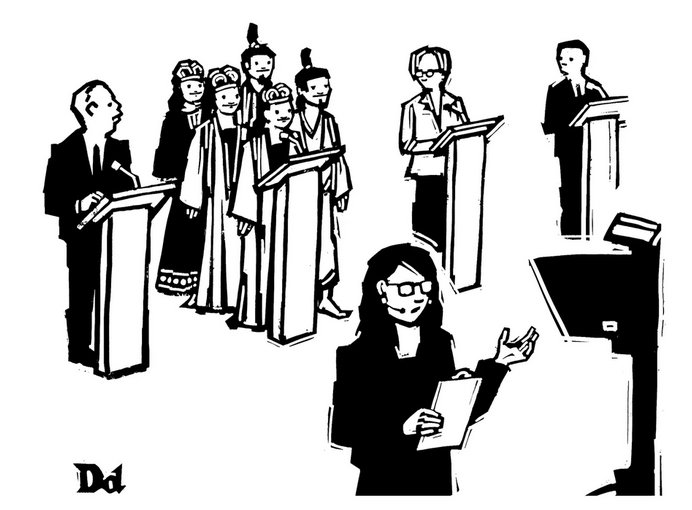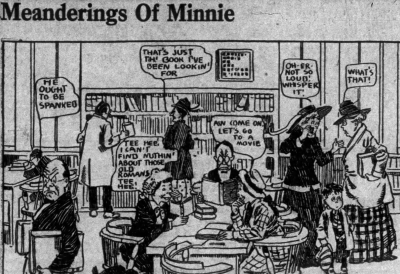Miss Cellany calls on Bryn Durgin and Navied Mahdavian, Jonathan Lemon, Barbara Brandon-Croft, Drew Dernavich, Chuck Asay, and Terry (‘Aislin’) Mosher.

Miss Cellany gets unstuck in time and pulls up this, what The Pulitzer Board would call Illustrated Reporting and Commentary. The Los Angeles Times calls it an “Op-Comic.” It’s a multi-panel opinion comic from two weeks ago and Bryn Durgin and Navied Mahdavian are dumbfounded with 3,362 book bans? What year is this, anyway? piece. (Yahoo carries it for people wanting to get around the paywall.)
Jonathan Lemon touches on the subject in today’s Rabbits Against Magic:

Indeed, what year is it?
**********
While Miss Cellany meanders, Barbara Brandon-Croft sojourned … to Nigeria.

As part of a three-day editorial cartooning workshop, Brandon-Croft joined veteran Nigerian cartoonist Wale Adenuga for a lively panel discussion on the significance of visual storytelling in shaping public opinion. Together, they highlighted the importance of freedom of expression as one of the key pillars of a vibrant democracy.
During a moderated interactive session with aspiring editorial cartoonists, students, and professors of journalism and creative arts, Brandon-Croft covered a range of topics including the creative process, the art of visual storytelling, writing and drawing comics, and getting noticed and published in national newspapers.
Among the many outlets covering Barbara’s visiting the country for a U.S. Speaker Program titled, “Sketch & Satire: The Art and Impact of Editorial Cartooning” is, most recently, P.M. Express.
**********
Continuing east Miss Cellany crosses a continent (Africa) and an ocean (Indian) to find Drew Dernavich being interviewed about cartooning by Ariana Haghighi for Honi Soit in Australia.

When asked what makes a ‘good cartoon’, Drew offered some tips: the caption should be as short as possible, and should avoid explaining the joke. The situation should also be “topical, really funny, and really surprising”, and “reaffirm something you know”, whilst preferably working on multiple levels.
To budding student cartoonists, Drew advised, “Don’t imitate a certain publication’s voice!”. Many aspects of a cartoon contribute to its voice — the brushstrokes, caption style and humour. Each New Yorker cartoon I’ve encountered is a fingerprint, telling different stories with different tools.
**********
Miss Cellany returns home to the United(?) States, to the Rocky Mountains in particular, where she finds…

The news can feel like a soap opera.
You stop watching for a few decades and when you tune back in, the same storylines are still chugging along. The same can apply to the headlines.
When award-winning former Gazette political cartoonist Chuck Asay started looking back through his old work for a new Pikes Peak Library District exhibit, he noticed the interchangeability of then and now.
The Colorado Springs Gazette interviews and profiles political cartoonist Chuck Asay on the eve of the Pikes Peak Library District’s “The Names Change But Issues Stay the Same” exhibit of Asay cartoons.
The Gazette notes “Asay’s work [was] provocative, but also sometimes funny, believes he has a knack for poking at or pushing people to explore why they think the way they do…”
That’s where Lisa Templeton at The Colorado Times Recorder starts their story about the cartoonist and exhibit.

The Pikes Peak Library District (PPLD) is poised to open “The Names Change but Issues Stay the Same,” an exhibition dedicated to the works of Chuck Asay, an editorial cartoonist whose tenure at the Colorado Springs Gazette was as notable for its longevity as it was for its divisiveness. The showcase, which features over 30 of Asay’s pieces, will debut on March 6 at Library 21c and East Library.
Spanning over three decades, Asay’s career has garnered both acclaim and controversy. His cartoons, candidly described on PPLD’s digital collections website as an outpouring of his “religious, right-wing, wacko views,” have consistently ignited debate concerning their depiction of sensitive subjects.
**********

Heading north Miss Cellany finds political cartoonist Terry Mosher (“Aislin”) remembering and paying tribute to the recently passed former Prime Minister of Canadian for The Montreal Gazette.
Older Gazette readers may find this hard to believe, but I always liked Brian Mulroney. It’s just that, as a cartoonist, I’ve never believed in friendship getting in the way of a good laugh or lampoon.
**********
The full Meanderings of Minnie cartoon by Edwina Dumm from 1916 as seen in the feature image:

